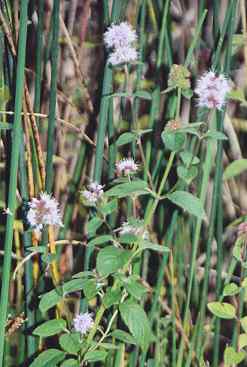
|
| Carinthian mint |

|
| Peppermint flower (Mitcham type) |
national beveragein Morocco and Tunisia.
British breeds of green mint are known as spearmint. They are very popular
for flavouring cold soups, beverages and meats; together with
thyme, spearmint is the most important culinary
herb in Britain. Spearmint is the mint
to use for the famous and often dreaded (by non-Englishmen) peppermint
sauce served to boiled lamb. Today, most spearmint is actually used in the
chewing gum industry (doublemint
).
Peppermint originated in England, probably due to accidental hybridization.
The oldest cultivar known, Black Mitcham, is named after a town
near London; its leaves are dark due to anthocyanin pigments. Other
varieties of peppermint are free from anthocyanins and are known as
white peppermint
.
In Britain, as in the rest of Europe, true peppermint is used almost exclusively for confectioneries and sweet liquors, where its cooling and fresh pungency balances the sweetness of the sugar. For all such purposes, the usage of pure essential oil is preferred in order to avoid the astringent to bitter notes of the peppermint leaves. The freshness of peppermint goes extremely well with chocolate flavour. Peppermint ice cream is especially delightful on a hot summer day, making use of the cooling properties of menthol (see vanilla).
Peppermint is much cultivated in many countries
of Europe, Western and Central Asia for the production of menthol, which
is needed in pharmaceutical preparations. In most of these countries,
peppermint entered local cuisine, replacing in part the native mints.

|
| Carinthian mint, close-up to flowers |
Fresh mint is essential to flavour a celebrated specialty of Carinthia,
Austria’s most Southern region bordering Italy, whence the art of noodle-making
was imported. Kärntner Kasnudeln (meaning loosely
Carinthian cheese-stuffed dumplings or Carinthian cheese-pasta)
are basically large ravioli-type noodles stuffed with a
mixture of cottage cheese, boiled potatoes and fresh herbs. The herb mixture
contains chervil and a special Carinthian mint
variety with caraway scent which somewhat remembers
spearmint. Boiled or steamed
Kasnudeln are served with a few
drops of molten butter as a snack between meals, or for dinner.

|
| Pennyroyal |
Fresh mint leaves are often used in Turkish cooking together with yoghurt (see garlic for an example); similar concoctions are in use in Lebanon and Israel (see parsley for the Lebanese salad tabbouleh). All over Western Asia, grilled lamb (kabab [كباب]) may be flavoured with mint, and dried mint is part of the Georgian spice mixture khmeli-suneli (see blue fenugreek). In the Caucasus countries, both regular mint and the related pennyroyal (M. pulegium) are used as garnish, which is curious, because pennyroyal, though having been an main herb in Classical Roman cooking (see also silphion), is not used in any other contemporary cuisine.
Iranian cuisine knows several highly sophisticated recipes employing mint, for example ghormeh [قرمه] (see feugreek), which is one of the fe examples where dried mint may be used. Some of these minty reciped were later transferred to Northern India where they were further developed, e. g., moghul-style biriyani (see saffron). Unlike the Western Asian foods containing mint, the Persian recipes can, at least for my taste, also be prepared with true peppermint.
In the Far East, mint is also well known. It is chiefly of importance in the
countries of peninsular South East Asia, less so in Indonesia and China.
In Thailand, local mint varieties are milder than European peppermint,
standing somewhere in between true peppermint and spearmint. Together with
other herbs, mainly basil and
coriander (cilantro),
mint is used in the hot Thai meat salad laab or
larb [ลาบ], which originates
from North Eastern Thailand (Isan [อีสาน]).
It is commonly prepared from chicken (then known as
laab gai [ลาบไก่])
and served with steamed glutinous rice as typical for the Isan region. Coarsely
ground chicken meat is dressed with typical Thai flavourings (fish sauce,
lime juice, shallots),
a liberal amount of dried red chiles, raw
vegetables and fresh greens, including coriander and mint leaves. Dried mint
is not suitable for Thai recipes.

|
| Orange mint (Eau de Cologne mint) |

|
| Mint plant in India |
Mint is also highly popular in Vietnam, where fresh aromatic leaves are, in any
case, essential for the national character of the food and thus served as a
garnish to nearly every Vietnamese dish, particularly in the South. The most
popular herbs (besides some that are rarely available in the West) for this
purpose are coriander,
Vietnamese coriander (also known as
Vietnamese mint
, which is confusing)
long coriander, basil
and mint. More often, a mild, spearmint- or
caraway-scented mint variety
(rau hung lui [rau húng lủi]) is preferred to the more pungent,
menthol-containing type (rau hung cay [rau húng cây]); the former is often
served with North Vietnamese, Hanoi-type noodle soup (pho bo [phở bò],
see Vietnamese cinnamon). See also
Vietnamese coriander for further details.














